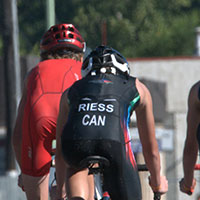When Dr. Ken Riess (Marketing ’91) thinks about the accident, memory fails him. “I don’t remember the impact of the crash,” he said of that warm summer morning in 2013.
One moment he was cycling along a south Edmonton roadside, finishing the last two kilometres of a 60K training ride. The next, he was on the ground surrounded by strangers saying that an ambulance was on the way and that he was going to be OK. Somehow, he’d hit the curb with enough force to completely but cleanly break his femur. “It’s funny – I never really felt any pain.”
Even at the hospital, the pain was more psychological than physical. A veteran Ironman competitor, Riess wondered if he’d ever run, bike or swim again. “I remember being really down about it,” said the 47-year-old NAIT Personal Fitness Trainer instructor.
Rather than give in to negativity, Riess embarked upon a goal-driven yet cautious regimen that today has him joking about “kicking 20-year-old Ken’s ass.” At the Ironman in Whistler, B.C. in July, Riess clocked 10:16 – an hour better than his first Ironman in 1990. The time qualified him to achieve a lifelong dream: competing in the Ironman World Championship in Hawaii.
In the weeks leading up to the Oct. 10, 2015 race – a 3.86-km swim, 180.25-km bicycle ride and a marathon (42.2 km) – we talked to Riess about how he beat the odds to race with the best in the world’s most prestigious triathlon.

Stay positive Riess believes he was in the best shape of his life at the time of the crash. He loathed the idea of taking a year off at his age. “I thought that’s it: I’ll never have a personal best again.”
After arriving home from the hospital – with a rod down his broken femur secured with two screws at his hip and two more at the knee – he quickly adjusted his attitude. His wife and two teenaged kids were as active as he was before the accident. “How do you sit on a sofa when everyone else is out there doing something?”
He stopped focusing on personal bests. Getting back to physical activity would be enough. “I pretty much didn’t take any time off from training,” said Riess. He hit the gym, working on upper body strength and rowing with his bad leg out to the side. He even started easy indoor cycling. “Thank god for Netflix,” he said.
Listen to experts
Then he asked his surgeon, who he saw monthly for six months, if – hypothetically speaking – he could start riding. “He said no.” Riess stopped. “As cool as I thought it would be to not listen to him, I didn’t want to mess around. I respected his opinion on everything.”
"I thought, 'That's it. I'll never have a personal best again.'"
“I thought, 'That’s it. I’ll never have a personal best again.'”
That wasn’t always easy. In late 2012, before the crash, Riess qualified for the Boston Marathon in 2014 and was planning to race. It was a year out – surely he could do it. He asked the surgeon, a runner himself. “He said, ‘No way. Let me put it this way: a year from now you’ll be running but I’ll be kicking your ass.’”
“I used that as motivation,” said Riess. But he didn’t go to Boston.
 Set goals
Set goals
Riess reintroduced sports slowly, setting goals to motivate himself and measure progress. “I wanted to have those progressions in place and know what my season was going to look like.”
Swimming came relatively easy, since Riess’s technique relies heavily on his upper body. Eventually returning to cycling, he discovered he was down only about 25 per cent from pre-crash metrics. Running was hardest. On his birthday, Oct. 6, 2013, he attempted a run of less than a kilometre.
“I couldn’t believe how hard it was,” said Riess. “I was bagged after that.”
Nevertheless, he started racing in 2014: the Canadian Birkebeiner in February, a half-Ironman in August, the New York City Marathon in November, where he finished in 3:14 – just 12 minutes behind his last marathon.
“It was a defining moment,” said Riess – the go ahead to sign up for Whistler in July, where he qualified for Hawaii.
Be realistic
“I’m still a competitive guy,” said Riess, but age and experience have made him respect the unknown. The possibility of heat in Hawaii on race day didn't worry him but humidity did, enough to set aside the possibility of a personal best (he finished in 11:36:10). What mattered most to him is that he made it.
“For many triathletes,” he said, “this is the highlight of their training.”
In a way, Riess's plan for race day was a reflection of his comeback: measured, disciplined and sensible. “It’s going to be very controlled,” he said. “I don’t want to make any mistakes. It’s going to be a very cautious race.”